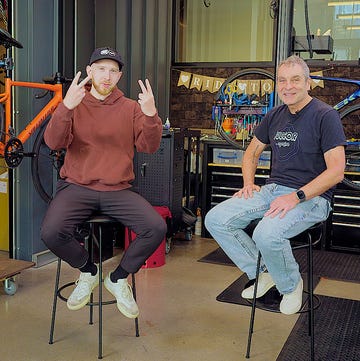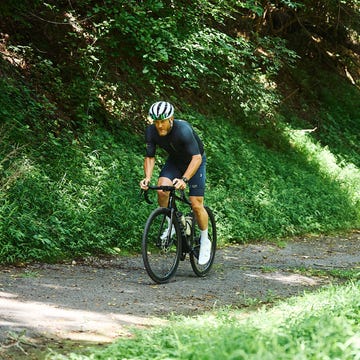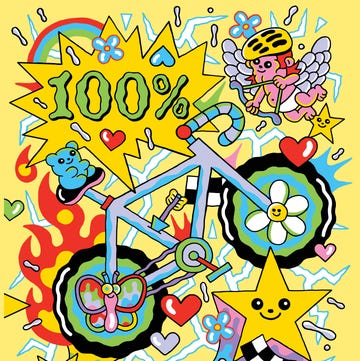The Takeaway: The updated Trek Émonda ALR is thoroughly modern, yet simple and fully upgradable. Just the way an aluminum road bike should be.
This is Trek’s third generation of the Émonda ALR. It’s the Wisconsin-based brand's take on premium-level aluminum race bikes, a segment largely dominated by Specialized’s Allez Sprint and the Cannondale CAAD series over the last few years.
The Émonda ALR borrows its geometry (down to the millimeter) from its much pricier (and lighter weight) carbon fiber version of the Émonda. This means riders get the same, proven, race-winning geometry of the much pricier carbon model for around one thousand dollars less.
While the cost savings might be the most enticing feature of the ALR for many riders, the updated aluminum frame is the showstopper here. Much like its carbon version, the Émonda ALR features a mix of aerofoil (Kammtail) shaped tubes along with more traditional round profiles. Trek uses its 300 Series Alpha aluminum for the frame, which weighs in at 1,257 grams (claimed), for a painted size 56cm. It’s combined with a full carbon fork that adds 406g to the total package. This is impressive—weighing a mere 34g more than Trek’s carbon Émonda SL variant of the frame (which sells for $1,000 more than the ALR).
The Émonda ALR frame is also refreshingly free from proprietary standards. The bike uses a T47 threaded bottom bracket, a round 27.2mm diameter seatpost, and a completely normal handlebar and stem combination using a 31.8 bar clamp and 1-⅛ steer tube. All of these things make the Émonda ALR an easy-to-live-with bike that can be upgraded and customized as riders see fit.
Alloy-frame aficionados have divided opinions about the appearance of welds. Some prefer to see the handy work of the welder and how tidy they can make the welds, while others prefer not to see the welds at all. Fans of chunky welds will be disappointed as Trek employed its Invisible Weld Technology on the Émonda ALR. This technique creates an incredibly seamless look to the frame. At arm's length (and particularly with the black frame), riders can easily mistake the Émonda ALR for a pricier carbon bike.
Another big change is at the Émonda’s front end. Trek implemented an integrated cable routing setup that’s very similar to the style used on the Allez Sprint. This setup sees the cable housing and brake hoses run externally along the bar and stem and then enter the frame through the top headset bearing. This kind of integration has the advantage of allowing riders to easily swap stem lengths or handlebars while still achieving a rather clean-looking cockpit. While Trek avoids the major headaches of cockpit customization with this cable routing solution, like many other recent road and gravel bikes, it suffers the added complexity and expense of routine service (such as replacing cables and housing or servicing headset bearings).
Unlike high-end bikes with electronic shifting—since the Émonda ALR is only sold with mechanical shifting—there are double the cables routing through the headset. Bikes with similar routing often face more rapid deterioration in shift performance (compared to bikes where things are routed externally) due to the tight bends the derailleur housing must make to fit into the space. It makes replacing cables and housing a major headache and costly if you’re not doing it yourself.
According to Cadence Cycling Center in Philadelphia, Pennsylvania, replacing a single-shift cable on a bike with through the headset routing can cost as much as $200 in labor. This is because shops tend to charge for this work by the hour and the time it takes to complete this service varies based on how complicated fishing the housing and cable is through the frame. To perform the same repair on a bike with externally routed cables, I was quoted a flat $25 labor charge.
Fit and Geometry
The Émonda ALR features the same H1.5 geometry that Trek uses on its Émonda and Madone carbon models. This geometry splits the difference between the aggressive H1 fit and the more relaxed H2 version. Meaning that a majority of riders should be able to find a good riding position regardless of whether they want to be long and low or more upright.
Additionally, Trek offers the Émonda ALR in a whopping eight sizes. The smallest size 47cm frame should be good for riders as short as 5’0”, and the largest size 62cm fits riders up to 6’5”, according to Trek.
The ALR Build
Trek currently offers only one complete bike Émonda ALR build. It features Shimano’s excellent 105 11-speed mechanical groupset, along with a Bontrager alloy bar, stem, and seatpost. Rounding things out is a pair of Bontrager alloy Paradigm SL wheels, which are very traditional with round J-bend spokes laced 2x but feature a 21mm internal width and are tubeless-ready. However, riders need to purchase the necessary items to turn them into tubeless wheels (including tubeless-specific tires, valves, and sealant).
Trek prices the Émonda ALR at $2,300 for the complete bike and $1,200 for the frameset.
Trek confirmed that the Émonda ALR will receive an update to 12-speed 105 in the near future. Unfortunately, Trek representatives have not told us how much it will cost or the complete specification list. (But for reference, a 12-speed 105-equipped Domane AL 5 sells for $2,000)
Ride Impressions
Aluminum road bikes often have a reputation for being overly stiff, harsh, and cheap (in a bad way). However, these traits are generally not found on modern and well-engineered aluminum frames. (And it’s such a pervasive stereotype that my colleague Matt Phillips wrote a whole column about it.)
While some bikes lean into aspects of that reputation (the Allez Sprint is an unapologetically stiff-as-hell criterium racing machine), the Émonda ALR takes a slightly different approach. Since it’s modeled after the carbon Émonda (a bike largely intended to win mountain stages in Grand Tour races), the ALR is designed with all-day comfort in mind. This makes the overall ride more relaxed and comfortable compared to the Allez Sprint and should be a plus for many riders.
Even if some might consider 11-speed 105 outdated (due to the recent launch of the 12-speed 105 R7100 components), Shimano’s 105 R7000-series drivetrain is an excellent and well-proven groupset. The 11-speed group has precise and crisp shifting front and rear and also impresses with powerful braking at the wheels and excellent control of the levers.
In contrast, the most disappointing part of the Émonda ALR’s build kit is its tires. Which would be the absolute first thing I upgrade. The Bontrager R1 wire-bead road tires weigh 360g per tire and are very much included to help meet the Émonda’s price point. They make the bike feel sluggish in a straight line while also not helping to foster any cornering confidence. A swap to even a mid-range tire from any of the major tire brands will probably drop around 30-40g of rotating weight per wheel and dramatically improve the ride quality of the bike.
I found the rest of the ALR’s Bontrager finishing kit perfectly serviceable. The seatpost, stem, and saddle were nothing flashy but did the job. The handlebar has a rather classic feeling bend, drop, and reach. Best of all, if any of these stock items don’t work for you, it’s simple to swap any of them out for a preferred version.
Out of the box, I found the Émonda’s ride quality quite good but perhaps a bit on the firm side. Lowering the tire pressure to around 68-72 psi range greatly improved the comfort. And once I swapped to a set of Continental GP5000 tires, the Émonda ALR really began to shine on the road.
There’s nothing gimmicky about the Émonda ALR. It’s a classic road bike in the simplest sense of the term. Riding it for the first time felt familiar and reassuring. The geometry didn’t require me to adjust to the bike—I could just get on and go. Even on that first ride, I felt like I could dive into corners with the assurance of knowing what the Émonda ALR would do when I leaned in. The geometry was a perfect mix of stability and responsiveness with a dash of that springiness that good metal bikes have.
On flat and rolling terrain, the Émonda ALR is right up there with almost any non-aero road bike of the last few years. Its dialed geometry makes it a pleasure to descend on, and the frame has the right snap to be a truly wonderful climber.
What holds the ALR back on the uphills, though, are the stock wheels. At 1,800 grams, they’re not as heavy as some wheels on bikes in this price range, but they just feel soft and unresponsive. After upgrading the tires, a new set of wheels would be my next purchase for the Émonda ALR.
One aspect of the Émonda ALR that feels a bit dated for a road bike made in 2023: Trek caps the bike’s maximum tire clearance at 28mm. In practice, there is enough room to comfortably run 30 or even 32mm tires (depending on the tire and rim combination). Still, I would feel better with a bit more official wiggle room, especially as it’s gotten harder to predict the measured width of various tire and rim combinations.
Overall, the Émonda ALR gets way more things right than it does wrong. While it's easy to nitpick things like its tires and wheels, Trek uses these parts to get the Émonda ALR to its modest price. And the ALR is up there with some of the best aluminum race bikes. It’s an impeccably finished and thoroughly well-designed aluminum bike that’s only a few grams heavier than its mid-tier carbon version. Plus, the Émonda ALR shares geometry with its pricier siblings and uses no proprietary standards or parts. With the ALR, Trek made a bike that nails all the things that have always made me love aluminum race bikes.
Test Editor Dan Chabanov got his start in cycling as a New York City bike messenger but quickly found his way into road and cyclocross racing, competing in professional cyclocross races from 2009 to 2019 and winning a Master’s National Championship title in 2018. Prior to joining Bicycling in 2021, Dan worked as part of the race organization for the Red Hook Crit, as a coach with EnduranceWERX, as well as a freelance writer and photographer.

























